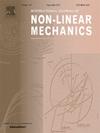用lindstedt - poincarcarr方法理解Mathieu三次五次Duffing系统的稳定性和分岔
IF 3.2
3区 工程技术
Q2 MECHANICS
International Journal of Non-Linear Mechanics
Pub Date : 2025-08-28
DOI:10.1016/j.ijnonlinmec.2025.105236
引用次数: 0
摘要
Mathieu方程是研究参数激励系统的一个基础模型,已经被广泛地运用解析和数值技术进行分析。由于其与各种物理和工程系统的相关性,我们研究了它的非线性扩展- Mathieu三次五次Duffing方程-其中包括三次和五次刚度项。这种非线性变异体具有丰富的动力学行为,包括复杂的稳定性转变和分岔。为了探索这些现象,我们采用了lindstedt - poincar本文章由计算机程序翻译,如有差异,请以英文原文为准。
Comprehending stability and bifurcations in Mathieu cubic–quintic Duffing system using Lindstedt–Poincaré methodology
The Mathieu equation serves as a foundational model in the study of parametrically excited systems and has been extensively analyzed using both analytical and numerical techniques. Motivated by its relevance to various physical and engineering systems, we investigate its nonlinear extension – the Mathieu cubic–quintic Duffing equation – which includes both cubic and quintic stiffness terms. This nonlinear variant exhibits rich dynamical behavior including complex stability transitions and bifurcations. To explore these phenomena, we employ the Lindstedt–Poincaré method, which allows us to analytically capture both pitchfork bifurcations (subcritical and supercritical) near unstable parametric resonance tongues and subharmonic bifurcations at higher values of excitation frequencies. The analytical predictions are validated using numerical simulations based on Poincaré sections. Our results reveal the emergence of two distinct unstable tongues centered around and , as well as two subharmonic bifurcations located at and . We construct a comprehensive global bifurcation diagram in the parametric frequency–excitation strength space, showing transitions in equilibrium stability and the birth of multiple stable and unstable equilibrium points. Notably, the transition through each bifurcation boundary results in a specific number of stable and unstable equilibrium points alternatively. These findings not only extend the known behavior of the Mathieu and Mathieu–Duffing systems but also offer deeper insight into the complex dynamics induced by higher-order nonlinearities.
求助全文
通过发布文献求助,成功后即可免费获取论文全文。
去求助
来源期刊
CiteScore
5.50
自引率
9.40%
发文量
192
审稿时长
67 days
期刊介绍:
The International Journal of Non-Linear Mechanics provides a specific medium for dissemination of high-quality research results in the various areas of theoretical, applied, and experimental mechanics of solids, fluids, structures, and systems where the phenomena are inherently non-linear.
The journal brings together original results in non-linear problems in elasticity, plasticity, dynamics, vibrations, wave-propagation, rheology, fluid-structure interaction systems, stability, biomechanics, micro- and nano-structures, materials, metamaterials, and in other diverse areas.
Papers may be analytical, computational or experimental in nature. Treatments of non-linear differential equations wherein solutions and properties of solutions are emphasized but physical aspects are not adequately relevant, will not be considered for possible publication. Both deterministic and stochastic approaches are fostered. Contributions pertaining to both established and emerging fields are encouraged.

 求助内容:
求助内容: 应助结果提醒方式:
应助结果提醒方式:


